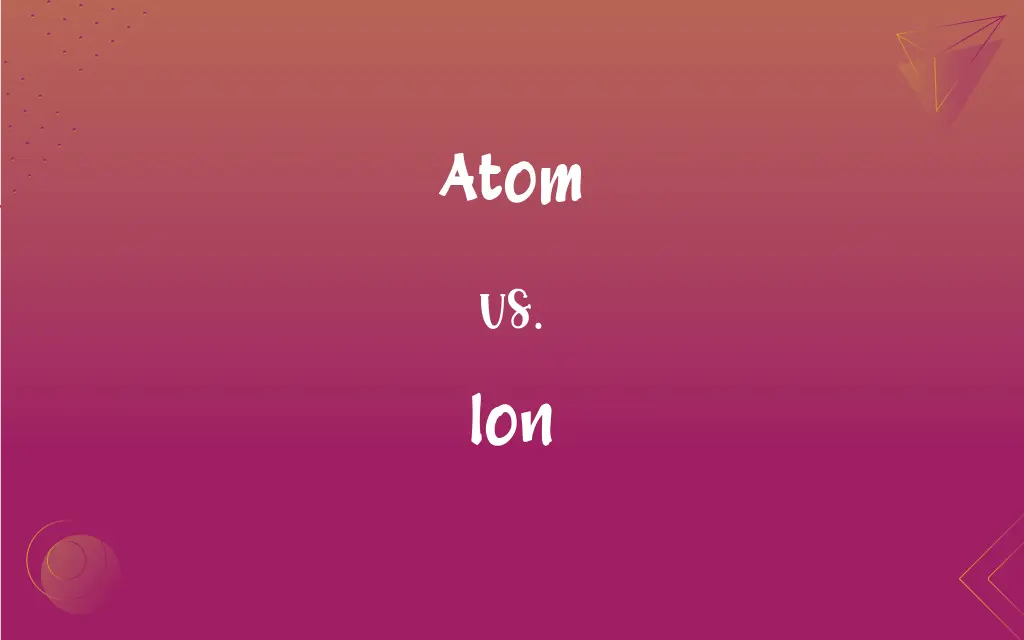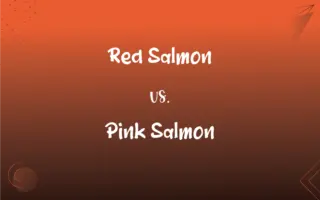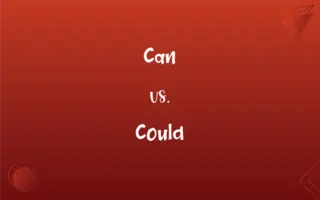Atom vs. Ion: What's the Difference?
Edited by Janet White || By Harlon Moss || Updated on October 20, 2023
An atom is the basic unit of an element, while an ion is an atom with a net electrical charge due to the loss or gain of electrons.

Key Differences
An atom represents the smallest unit of an element that retains the properties of that element. Each atom is composed of protons, neutrons, and electrons. These components are found in specific areas of the atom, with protons and neutrons in the nucleus and electrons orbiting around them.
In contrast, an ion forms when an atom loses or gains electrons, resulting in a net electrical charge. Ions can be positively charged (called cations) when they lose electrons, or negatively charged (called anions) when they gain electrons. The process by which atoms become ions is known as ionization.
While an atom, in its neutral state, has an equal number of protons and electrons, ensuring no net charge, an ion always carries a charge. The nature of this charge, whether positive or negative, determines many of the ion's properties and behaviors in various chemical reactions.
Atoms play a foundational role in understanding matter and its properties. Everything in the universe, from the air we breathe to the ground we walk on, consists of atoms. Ions, on the other hand, are crucial in numerous natural processes and technological applications, from conducting electricity in our bodies to generating power in batteries.
In essence, while both atoms and ions are fundamental in the realm of chemistry and physics, their defining feature is their charge state. Atoms are neutral, with balanced protons and electrons, whereas ions have an imbalance due to electron movement, leading to their charged nature.
ADVERTISEMENT
Comparison Chart
Definition
Basic unit of an element
Atom with a net electrical charge
Charge
Neutral
Can be positive or negative
Electron Count
Equal to proton count
More or fewer electrons than protons
Formation
Naturally occurring
Formed by gaining or losing electrons
Role
Fundamental building block of matter
Participates in chemical reactions and conducts electricity
ADVERTISEMENT
Atom and Ion Definitions
Atom
A neutral entity with equal protons and electrons.
An atom of helium has two protons and two electrons.
Ion
Results from the loss or gain of electrons.
When sodium loses an electron, it becomes a positive ion.
Atom
Represents the elemental form of matter.
Gold jewelry is made from gold atoms.
Ion
Crucial in electrical conductivity.
Ions in the body help transmit nerve impulses.
Atom
Essential building block in chemical reactions.
Atoms combine in different ways to form molecules.
Ion
An atom or molecule with a net electrical charge.
Salt dissolves in water to form sodium and chloride ions.
Atom
The smallest unit of an element.
Water is made up of hydrogen and oxygen atoms.
Ion
Can be either positively (cation) or negatively (anion) charged.
A chloride ion is an example of a negative ion.
Atom
A particle with a nucleus surrounded by electrons.
Each atom has a unique number of protons in its nucleus.
Ion
Frequently participates in chemical reactions.
Calcium ions play a key role in muscle contraction.
Atom
A part or particle considered to be an irreducible constituent of a specified system.
Ion
An atom or a group of atoms that has acquired a net electric charge by gaining or losing one or more electrons.
Atom
The irreducible, indestructible material unit postulated by ancient atomism.
FAQs
Are all atoms neutral?
Yes, atoms are neutral with equal numbers of protons and electrons.
Why are ions important in the body?
Ions help with nerve impulse transmission, muscle contraction, and maintaining pH balance.
Can an atom become an ion?
Yes, when an atom gains or loses electrons, it becomes an ion.
How are ions formed?
Ions are formed through ionization, where atoms lose or gain electrons.
Do atoms exist alone in nature?
Atoms can exist alone or bonded with other atoms to form molecules.
What happens when an atom loses an electron?
When an atom loses an electron, it becomes a positive ion or cation.
Do ions always have a charge?
Yes, ions always have a net electrical charge, either positive or negative.
What's the difference between an atom's atomic number and its charge?
The atomic number represents the number of protons, while the charge indicates the net electrical state of the ion.
Why do atoms form ions?
Atoms form ions to achieve a stable electron configuration, often resembling noble gases.
Do all elements form ions?
Not all, but many elements can form ions, especially metals and non-metals.
What's the significance of ions in batteries?
In batteries, ions move between electrodes, facilitating the flow of electricity.
How do ions interact in solutions?
Ions can attract or repel each other, conduct electricity, and participate in chemical reactions.
Why are atoms considered the building blocks of matter?
Because everything is made up of atoms, and they retain the properties of elements.
Are atoms larger than ions?
It depends. Cations (positive ions) are typically smaller than their parent atoms, while anions (negative ions) are larger.
Can an ion be neutral?
No, by definition, an ion has a net electrical charge.
What determines the type of ion an atom will form?
The atom's electron configuration and its desire to achieve stability typically determine the type of ion it will form.
How can you identify an ion's charge?
The charge is typically indicated by a plus or minus sign and a number, like +1 or -2.
Can an ion go back to being a neutral atom?
Yes, if an ion gains or loses the right number of electrons, it can become a neutral atom.
Can molecules also become ions?
Yes, when molecules gain or lose electrons, they can become ions.
Can ions exist in a gaseous state?
Yes, ions can exist in gaseous states, often seen in processes like ionization in mass spectrometry.
About Author
Written by
Harlon MossHarlon is a seasoned quality moderator and accomplished content writer for Difference Wiki. An alumnus of the prestigious University of California, he earned his degree in Computer Science. Leveraging his academic background, Harlon brings a meticulous and informed perspective to his work, ensuring content accuracy and excellence.
Edited by
Janet WhiteJanet White has been an esteemed writer and blogger for Difference Wiki. Holding a Master's degree in Science and Medical Journalism from the prestigious Boston University, she has consistently demonstrated her expertise and passion for her field. When she's not immersed in her work, Janet relishes her time exercising, delving into a good book, and cherishing moments with friends and family.































































